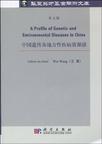中国遗传及地方性疾病资源谱
出版时间:2009-1 出版社:王嵬 科学出版社 (2009-01出版) 作者:王嵬 著 页数:302
前言
Genetic disorders are commonly found in every community and endemicdiseases are restected in specific geographical areas in China. Traditionally recognized hereditary disorders in the form of chromosomal, single gene and complexmedical diseases have a prevalence of about 20%-25%. If acquired genetic disor-ders and somatic genetic disorders such as cancer are included, the prevalence iseven higher. Given the huge burden of genetic disorders on patients, families andthe community,it is essential to study their mechanisms and bring forth powerfulpreventive measures. To effectively control the genetic disorders and endemic dis-eases in China, the first priority is the systematic collection of basic data such asprevalence of various disorders and endemic diseases, contributing factors, andvariations in expression among different ethnic groups and the general population. However,until now there has been no Chinese books or scientific journalsaddressing this issue.This book collects those information mentioned above and discusses in detail,the most commonly found multigene genetic disorders, single gene genetic disorders and chromosomal genetic disorders among Chinese,and also the endemic diseases in different parts of China. The choice of the disorders in this book wasbased on published Chinese epidemiological data. The emphasis of this book isfocused on the disease prevalence, in different populations and regions home andabroad, the trend of alterations of prevalence,and a brief introduction to the pres-ent status of research and therapy available in China and in the world. Geneticdisorders and endemic diseases in minority groups in China, genetic studies inisolated and semiisolated communities of Chinese, and major influencing factorsare also discussed.
内容概要
The book can be used by medical students as a supplementary textbook. It is also of great value as a reference for health professionals and physicians. Multiple copies of this valuable book should also be on the shelves of all universities,medical schools and research establishments where these subjects are studied.
书籍目录
A Brief IntroductionForewordAcknowledgementsCHAPTER 1 China and its peoples1.1 Chinese population demographics1.2 The Han and the ethnic minorities1.3 Geographical characteristics1.4 Population size and growth1.5 Population age structure1.6 Migration1.7 Urbanization1.8 Marriage patterns1.9 Fertility patterns(including the One-Child-Family programme)1.10 Maternal mortality1.11 Mortality patterns1.12 ConclusionReferencesCHAPTER 2 Single gene disorders2.1 Introduction2.2 Amino acid (and/or other) disorders2.3 Hemoglobinopathies2.4 The influence of nutritional factors on the expressions of geneticdisorders2.5 ConclusionReferencesCHAPTER 3 Chromosomal disorders3.1 General overview3.2 Down syndrome3.3 Symptoms and comorbidities3.4 Etiology3.5 Factors3.6 Treatments and prevention3.7 ConclusionReferencesCHAPTER 4 Congenital disorders4.1 Introduction4.2 Congenital heart disease4.3 Neural tube defects4.4 Oral and facial clefts4.5 Case study:congenital deafness4.6 ConclusionReferencesCHAPTER 5 Psoriasis and eczema5.1 Introduction5.2 Epidemiology5.3 Etiology and pathogenesis5.4 Symptoms5.5 Treatments and prevention5.6 Eczema5.7 ConclusionReferencesCHAPTER 6 Essential epilepsy6.I Introduction6.2 Symptoms6.3 Epidemiology6.4 Etiology6.5 Treatment and prevention6.6 ConclusionReferencesCHAPTER 7 Behavioral and psychiatric disorders7.1 General overview7.2 Case study 17.3 Case study 27.4 ConclusionReferencesCHAPTER 8 Cardiovascular disease8.1 Overview8.2 Case study:hypertension8.3 Epidemiology8.4 Cardiovascular disease as the primary cause of death and hyperterthe main simply treatable risk factor8.5 Etiology8.6 Treatments and preventionReferencesCHAPTER 9 Epidemiology and risk factors of common cancers9.1 Breast cancer9.2 Nasopharyngeal carcinoma9.3 Lung cancer9.4 Stomach cancer9.5 Colorectal cancer9.6 Liver cancer9.7 Case study:esophageal cancerReferencesCHAPTER 10 Dietary deficiency disorders10.1 Overview10.2 Iodine deficiency10.3 Symptoms10.4 Etiology10.5 Pathogenesis10.6 Pathology of endemic goiter10.7 Prevention and treatments10.8 Conclusion10.9 Keshan disease10.10 Epidemiology10.11 Pathology10 12 Etiology10 13 Pathogenesis10 14 Clinical and laboratory investigations10 15 Diagnosis10.16 TreatmentReferencesCHAPTER 11 Environmental toxicity disorders11.1 Endemic fluorosis11.2 Epidemiology11.3 Pathology11.4 Symptoms and stages11.5 Clinical diagnosis and differential diagnosis11.6 Prevention11.7 Conclusion11.8 Endemic arsenic poisoning11.9 Epidemiology11.10 Etiology11.11 Pathology11.12 Pathogenesis11.13 Clinical manifestations11.14 Clinical diagnosis and differential diagnosis11.15 Endemic arsenic poisoning prevention and treatmentReferencesCHAPTER 12 Combined deficiency-toxicity disorders12.1 Kashin-Beck Disease12.2 Symptoms12.3 Geographical distribution12.4 Population prevalence12.5 Family occurrence12.6 Etiology12.7 Pathology12.8 Pathogenesis12.9 Prevention and treatment12.10 Differential diagnosis12.11 ConclusionReferencesCHAPTER 13 Bioethical and legislative restrictions in China13.1 Family planning programs13.2 Eugenics laws and sex selection13.3 Disabled people and moral protection in China13.4 Sex ethnic13.5 Sexually transmitted diseases13.6 Confucian ethics and the market economyReferences
章节摘录
插图:A clinical method in China,"Wu Zang Shu" pinpricking and cupping has beenapplied to treat psoriasis vulgaris and was proven to be effective with an efficacyrate of 94. 1%. Clinical practice has confirmed that this method improves theerythema and infiltration scales. The method can modify the immune response,relieving the inflammatory reactions, and improving the skin's microcirculation,thus relieving the severity of lesions.Treatments for psoriasis range from topical therapies for mild disease tophototherapy or systemic therapy for more widespread disease. Despite manyshortcomings, topical drugs will remain the mainstay of psoriasis therapy for mostpatients. Emollients such as petrolatum may be effective. Other treatments suchas topical steroids, anthralin, vitamin D analogues, UV light, and ancient remedieslike coal tar may all be useful. Aside from their marginal effectiveness, the stai-ning caused by tars has greatly limited their use. Attempts to make tar not greasyor not stainning have not been successful, partly because the messiest tars seem tobe the'most effective. Anthralin is a tar derivative, and the use of anthralin hasinnovative application methods and new vehicles. Short application times, withhigh concentrations of anthralin such as 1% preparations, can be as effective asovernight or day-long application of lower concentrations. More recently,vehi-cles that release anthralin at body surface temperature have been used to keepstaining of household items to a minimum.
编辑推荐
《中国遗传及地方性疾病资源谱(英文版)》为华夏英才基金学术文库之一。
图书封面
评论、评分、阅读与下载
